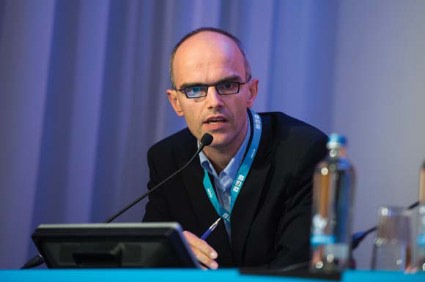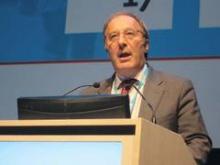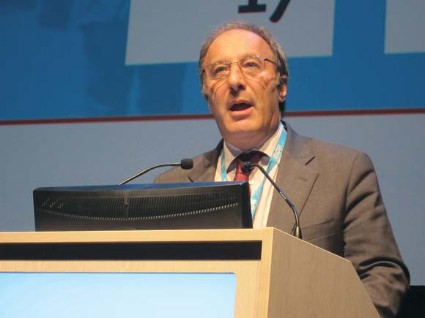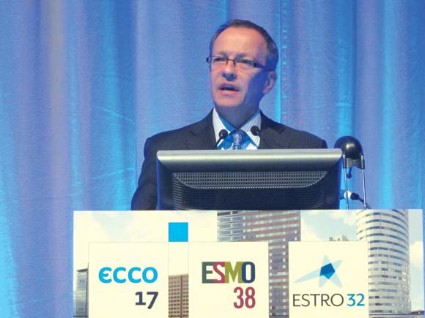User login
ECCO 17 - 38th ESMO European Cancer Congress
T-DM1 tops physician’s choice in advanced HER2-positive breast cancer
AMSTERDAM – Ado-trastuzumab emtansine nearly doubled the time to disease progression for women with heavily pretreated, HER2-positive metastatic breast cancer compared with physician’s choice of treatment in the open-label, phase III TH3RESA trial.
Median progression-free survival was 6.2 months with ado-trastuzumab emtansine (Kadcyla), previously known as T-DM1, and 3.3 months with a treatment of physician’s choice (hazard ratio 0.528; P less than .0001).
Physician’s choice included chemotherapy and trastuzumab (Herceptin) (68.5%), lapatinib and trastuzumab (10.3%), chemotherapy and lapatinib (2.7%), and hormonal therapy and trastuzumab (1.6%).
An interim overall survival analysis also favored T-DM1 (median not reached vs. 14.9 months; HR 0.552; P = .0034), with the final analysis expected in 2015, Dr. Hans Wildiers said in a presidential session at the multidisciplinary European cancer congresses.
The data reaffirm results from the phase III EMILIA trial, demonstrating a consistent benefit with T-DM1 in previously treated human epidermal growth factor receptor 2–positive (HER2-positive) advanced breast cancer.
"In my opinion, combining EMELIA and TH3RESA, T-DM1 should become the standard of care," he added.
As previously reported, EMILIA showed a 5-month gain in overall survival with T-DM1 over capecitabine (Xeloda) plus lapatinib (Tykerb) in relapsed, metastatic breast cancer.
This led to the approval of T-DM1 in February 2013 in the United States for the treatment of HER2-positive metastatic breast cancer previously treated with trastuzumab and a taxane. T-DM1 is expected to gain European Union approval by the end of the year, according to Genentech, which markets the drug.
Notably, a total of 80.4% of patients in that arm received a regimen containing trastuzumab.* Median progression-free survival (PFS) in this subgroup was significantly extended by 3 months with T-DM1 compared with physician’s choice (3.2 vs. 6.2; HR 0.558; P less than .001), said Dr. Wildiers of University Hospitals Leuven, Belgium.
Commenting on the results, invited discussant Dr. Clifford Hudis, chief of breast cancer medicine service at Memorial Sloan-Kettering Cancer Center in New York, said he is optimistic T-DM1 will deliver an overall survival advantage because prior research has shown that a small incremental improvement in PFS, measured in weeks, can lead to an improvement in months in overall survival simply by reintroducing trastuzumab (J. Clin. Oncol. 2012;30:2585-92).
"A definitive and clinically meaningful overall survival may just be what some markets need to bless this approach, but cost will be an issue," he said. "Arguably, we’re more willing to tolerate the higher cost when overall survival is improved, but even without it, I would see the toxicity advantage as worth a lot."
Patients treated with T-DM1 were less likely than were those given their physician’s choice to reduce dosage (9.4% vs. 19.6%) or stop treatment due to an adverse event (6.7% vs. 11%), Dr. Wildiers said. Grade 3 or higher adverse events were also lower with T-DM1 (32.3% vs. 43.5%).
Significantly more women also responded to T-DM1 than to their physician’s choice (31.3% vs. 8.6%; P less than .001). Further, analyses showed "a clear and consistent effect" that T-DM1 was better across all subgroups, he said.
When pressed by the audience on how T-DM1 should be used in clinical practice, Dr. Wildiers said T-DM1 should likely be reserved for the second-line setting until results are known from the ongoing MARIANNE trial. The phase III trial is evaluating T-DM1 with pertuzumab (Perjeta) versus trastuzumab plus a taxane in women with HER2-positive progressive or recurrent locally advanced or previously untreated metastatic breast cancer.
Dr. Wildiers reported serving on an advisory board for Roche. His coauthors disclosed ties with several firms, including employment with Genentech, which markets ado-trastuzumab emtansine.
*CORRECTION, 10/10/13: A previous version of this story did not clearly describe the patients who received trastuzumab in the physician's choice arm of TH3RESA.
AMSTERDAM – Ado-trastuzumab emtansine nearly doubled the time to disease progression for women with heavily pretreated, HER2-positive metastatic breast cancer compared with physician’s choice of treatment in the open-label, phase III TH3RESA trial.
Median progression-free survival was 6.2 months with ado-trastuzumab emtansine (Kadcyla), previously known as T-DM1, and 3.3 months with a treatment of physician’s choice (hazard ratio 0.528; P less than .0001).
Physician’s choice included chemotherapy and trastuzumab (Herceptin) (68.5%), lapatinib and trastuzumab (10.3%), chemotherapy and lapatinib (2.7%), and hormonal therapy and trastuzumab (1.6%).
An interim overall survival analysis also favored T-DM1 (median not reached vs. 14.9 months; HR 0.552; P = .0034), with the final analysis expected in 2015, Dr. Hans Wildiers said in a presidential session at the multidisciplinary European cancer congresses.
The data reaffirm results from the phase III EMILIA trial, demonstrating a consistent benefit with T-DM1 in previously treated human epidermal growth factor receptor 2–positive (HER2-positive) advanced breast cancer.
"In my opinion, combining EMELIA and TH3RESA, T-DM1 should become the standard of care," he added.
As previously reported, EMILIA showed a 5-month gain in overall survival with T-DM1 over capecitabine (Xeloda) plus lapatinib (Tykerb) in relapsed, metastatic breast cancer.
This led to the approval of T-DM1 in February 2013 in the United States for the treatment of HER2-positive metastatic breast cancer previously treated with trastuzumab and a taxane. T-DM1 is expected to gain European Union approval by the end of the year, according to Genentech, which markets the drug.
Notably, a total of 80.4% of patients in that arm received a regimen containing trastuzumab.* Median progression-free survival (PFS) in this subgroup was significantly extended by 3 months with T-DM1 compared with physician’s choice (3.2 vs. 6.2; HR 0.558; P less than .001), said Dr. Wildiers of University Hospitals Leuven, Belgium.
Commenting on the results, invited discussant Dr. Clifford Hudis, chief of breast cancer medicine service at Memorial Sloan-Kettering Cancer Center in New York, said he is optimistic T-DM1 will deliver an overall survival advantage because prior research has shown that a small incremental improvement in PFS, measured in weeks, can lead to an improvement in months in overall survival simply by reintroducing trastuzumab (J. Clin. Oncol. 2012;30:2585-92).
"A definitive and clinically meaningful overall survival may just be what some markets need to bless this approach, but cost will be an issue," he said. "Arguably, we’re more willing to tolerate the higher cost when overall survival is improved, but even without it, I would see the toxicity advantage as worth a lot."
Patients treated with T-DM1 were less likely than were those given their physician’s choice to reduce dosage (9.4% vs. 19.6%) or stop treatment due to an adverse event (6.7% vs. 11%), Dr. Wildiers said. Grade 3 or higher adverse events were also lower with T-DM1 (32.3% vs. 43.5%).
Significantly more women also responded to T-DM1 than to their physician’s choice (31.3% vs. 8.6%; P less than .001). Further, analyses showed "a clear and consistent effect" that T-DM1 was better across all subgroups, he said.
When pressed by the audience on how T-DM1 should be used in clinical practice, Dr. Wildiers said T-DM1 should likely be reserved for the second-line setting until results are known from the ongoing MARIANNE trial. The phase III trial is evaluating T-DM1 with pertuzumab (Perjeta) versus trastuzumab plus a taxane in women with HER2-positive progressive or recurrent locally advanced or previously untreated metastatic breast cancer.
Dr. Wildiers reported serving on an advisory board for Roche. His coauthors disclosed ties with several firms, including employment with Genentech, which markets ado-trastuzumab emtansine.
*CORRECTION, 10/10/13: A previous version of this story did not clearly describe the patients who received trastuzumab in the physician's choice arm of TH3RESA.
AMSTERDAM – Ado-trastuzumab emtansine nearly doubled the time to disease progression for women with heavily pretreated, HER2-positive metastatic breast cancer compared with physician’s choice of treatment in the open-label, phase III TH3RESA trial.
Median progression-free survival was 6.2 months with ado-trastuzumab emtansine (Kadcyla), previously known as T-DM1, and 3.3 months with a treatment of physician’s choice (hazard ratio 0.528; P less than .0001).
Physician’s choice included chemotherapy and trastuzumab (Herceptin) (68.5%), lapatinib and trastuzumab (10.3%), chemotherapy and lapatinib (2.7%), and hormonal therapy and trastuzumab (1.6%).
An interim overall survival analysis also favored T-DM1 (median not reached vs. 14.9 months; HR 0.552; P = .0034), with the final analysis expected in 2015, Dr. Hans Wildiers said in a presidential session at the multidisciplinary European cancer congresses.
The data reaffirm results from the phase III EMILIA trial, demonstrating a consistent benefit with T-DM1 in previously treated human epidermal growth factor receptor 2–positive (HER2-positive) advanced breast cancer.
"In my opinion, combining EMELIA and TH3RESA, T-DM1 should become the standard of care," he added.
As previously reported, EMILIA showed a 5-month gain in overall survival with T-DM1 over capecitabine (Xeloda) plus lapatinib (Tykerb) in relapsed, metastatic breast cancer.
This led to the approval of T-DM1 in February 2013 in the United States for the treatment of HER2-positive metastatic breast cancer previously treated with trastuzumab and a taxane. T-DM1 is expected to gain European Union approval by the end of the year, according to Genentech, which markets the drug.
Notably, a total of 80.4% of patients in that arm received a regimen containing trastuzumab.* Median progression-free survival (PFS) in this subgroup was significantly extended by 3 months with T-DM1 compared with physician’s choice (3.2 vs. 6.2; HR 0.558; P less than .001), said Dr. Wildiers of University Hospitals Leuven, Belgium.
Commenting on the results, invited discussant Dr. Clifford Hudis, chief of breast cancer medicine service at Memorial Sloan-Kettering Cancer Center in New York, said he is optimistic T-DM1 will deliver an overall survival advantage because prior research has shown that a small incremental improvement in PFS, measured in weeks, can lead to an improvement in months in overall survival simply by reintroducing trastuzumab (J. Clin. Oncol. 2012;30:2585-92).
"A definitive and clinically meaningful overall survival may just be what some markets need to bless this approach, but cost will be an issue," he said. "Arguably, we’re more willing to tolerate the higher cost when overall survival is improved, but even without it, I would see the toxicity advantage as worth a lot."
Patients treated with T-DM1 were less likely than were those given their physician’s choice to reduce dosage (9.4% vs. 19.6%) or stop treatment due to an adverse event (6.7% vs. 11%), Dr. Wildiers said. Grade 3 or higher adverse events were also lower with T-DM1 (32.3% vs. 43.5%).
Significantly more women also responded to T-DM1 than to their physician’s choice (31.3% vs. 8.6%; P less than .001). Further, analyses showed "a clear and consistent effect" that T-DM1 was better across all subgroups, he said.
When pressed by the audience on how T-DM1 should be used in clinical practice, Dr. Wildiers said T-DM1 should likely be reserved for the second-line setting until results are known from the ongoing MARIANNE trial. The phase III trial is evaluating T-DM1 with pertuzumab (Perjeta) versus trastuzumab plus a taxane in women with HER2-positive progressive or recurrent locally advanced or previously untreated metastatic breast cancer.
Dr. Wildiers reported serving on an advisory board for Roche. His coauthors disclosed ties with several firms, including employment with Genentech, which markets ado-trastuzumab emtansine.
*CORRECTION, 10/10/13: A previous version of this story did not clearly describe the patients who received trastuzumab in the physician's choice arm of TH3RESA.
AT THE EUROPEAN CANCER CONGRESS 2013
Major finding: Median progression-free survival was 6.2 months with T-DM1 vs. 3.3 months with physician’s choice of treatment (P less than .0001).
Data source: An open-label, phase III study of 602 women with HER2-positive metastatic breast cancer.
Disclosures: Dr. Wildiers reported serving on an advisory board for Roche. His coauthors disclosed ties with several firms, including employment with Genentech, which markets ado-trastuzumab emtansine.
ICON6 ovarian cancer results may resurrect cediranib
AMSTERDAM – Cediranib plus chemotherapy followed by cediranib maintenance treatment stalled recurrence and death by roughly 3 months in women with platinum-sensitive, relapsed ovarian cancer in the ICON6 study.
"This is the first trial to demonstrate a significant improvement in the progression-free and overall survival with an oral VEGF tyrosine kinase inhibitor in ovarian cancer, and these results suggest that cediranib has a clinically meaningful role in the treatment of recurrent ovarian cancer," Professor Jonathan Ledermann said at the multidisciplinary European cancer congresses.
The phase III results may provide women with another treatment option and bring cediranib (Recentin) back to life. AstraZeneca ceased development of the small molecule vascular endothelial growth factor (VEGF) inhibitor in September 2011 following disappointing results in first-line metastatic colorectal cancer, as well as non-small cell lung cancer
The three-arm, double-blinded ICON6 Gynecologic Cancer Intergroup Trial enrolled 456 women with epithelial ovarian, fallopian tube, or serous primary peritoneal cancer relapsing more than 6 months after first-line chemotherapy.
Patients were randomly assigned to platinum-based chemotherapy plus placebo and placebo maintenance therapy (chemotherapy-only arm) or cediranib 20 mg/day during chemotherapy followed by placebo (concurrent arm), or cediranib 20 mg/day during chemotherapy followed by maintenance cediranib (maintenance arm).
Treatment continued for 18 months or until disease progression, but could be used longer for patients continuing to benefit. Chemotherapy was up to six cycles of carboplatin (Paraplatin)/paclitaxel (Taxol), carboplatin/gemcitabine (Gemzar), or single-agent platinum therapy.
Median progression-free survival (PFS) was 8.7 months in the chemotherapy arm and 11.1 months in the cediranib maintenance arm (hazard ratio, 0.57; P = .00001).
However, because a test for nonproportionality was positive (P = .024), a restricted means analysis was done, resulting in a 3.1 month difference favoring cediranib (9.4 months vs. 12.5 months), said Prof. Ledermann, with University College London (UCL) Cancer Institute, Cancer Research UK, and UCL Cancer Trials Centre, London.
As a secondary endpoint, an analysis was performed on the concurrent arm showing a trend in favor of cediranib, with a PFS of 10.1 months and 11.4 months using restricted means analysis.
"There is strong evidence that cediranib has an effect by itself on progression-free survival both during and after chemotherapy," Prof. Ledermann said.
Median overall survival reached 20.3 months in the chemotherapy arm and 26.3 months in the cediranib maintenance arm (HR, 0.70; P = .042). Overall survival fell to 17.6 months and 20.3 months, respectively, in a restricted means analysis, following a positive test for nonproportionality (P = .0042). No overall survival data were presented for the concurrent arm.
"These are important results for women with recurrence ovarian cancer," Prof. Cornelis van de Velde, European Cancer Organization president, commented in a statement. "Once the disease has recurred, there are few treatment options available that make a significant difference to its progression and to overall survival. The ICON6 trial shows that cediranib does make a difference and it is to be hoped that it can be made available to women as soon as is practicable."
Laura Woodin, U.S. science media director for AstraZeneca, said in an interview that the company welcomes the commitment of the ICON6 investigators and the study sponsor, Britain’s Medical Research Council, and that "We look forward to assessing the positive results from the ICON6 study in more detail, to determine the future potential for cediranib in ovarian cancer."
Invited discussant Prof. Ignace Vergote, head of gynecological oncology at University Hospitals Leuven, Belgium, questioned why overall survival was so low in ICON6, compared with a median of 35.5 months reported with the addition of the VEGF-inhibitor bevacizumab to platinum-based chemotherapy in recurrent ovarian cancer in the phase III OCEANS trial. The cediranib dose was reduced from 30 mg/day to 20 mg/day after part one of ICON6, but it is unclear whether a higher dose in the maintenance phase would be more effective because 30-45 mg are used in most trials of cediranib monotherapy. Also unknown is whether there was less treatment in ICON6 after progression than there was in OCEANS.
The 15-month difference in overall survival between the two trials, however, might explain why overall survival was significant in ICON6 and not in the OCEANS study, Prof. Vergote said.
Finally, cediranib was associated with more treatment discontinuation, diarrhea, and fatigue, but less hypertension than bevacizumab at the dose used in the study, he observed.
Prof. Ledermann said hypertension (P = .004), diarrhea (P less than .001), and nausea (P = .008) were all significantly worse when cediranib was given during chemotherapy, but when it came to the maintenance phase, "hypertension was really quite manageable by this stage and the only side effect that was significantly worse with cediranib was diarrhea [P less than .001]."
Prof. Ledermann and his coauthors reported no relevant disclosures. AstraZeneca provided the study drug. Britain’s Medical Research Council sponsored the trial.
AMSTERDAM – Cediranib plus chemotherapy followed by cediranib maintenance treatment stalled recurrence and death by roughly 3 months in women with platinum-sensitive, relapsed ovarian cancer in the ICON6 study.
"This is the first trial to demonstrate a significant improvement in the progression-free and overall survival with an oral VEGF tyrosine kinase inhibitor in ovarian cancer, and these results suggest that cediranib has a clinically meaningful role in the treatment of recurrent ovarian cancer," Professor Jonathan Ledermann said at the multidisciplinary European cancer congresses.
The phase III results may provide women with another treatment option and bring cediranib (Recentin) back to life. AstraZeneca ceased development of the small molecule vascular endothelial growth factor (VEGF) inhibitor in September 2011 following disappointing results in first-line metastatic colorectal cancer, as well as non-small cell lung cancer
The three-arm, double-blinded ICON6 Gynecologic Cancer Intergroup Trial enrolled 456 women with epithelial ovarian, fallopian tube, or serous primary peritoneal cancer relapsing more than 6 months after first-line chemotherapy.
Patients were randomly assigned to platinum-based chemotherapy plus placebo and placebo maintenance therapy (chemotherapy-only arm) or cediranib 20 mg/day during chemotherapy followed by placebo (concurrent arm), or cediranib 20 mg/day during chemotherapy followed by maintenance cediranib (maintenance arm).
Treatment continued for 18 months or until disease progression, but could be used longer for patients continuing to benefit. Chemotherapy was up to six cycles of carboplatin (Paraplatin)/paclitaxel (Taxol), carboplatin/gemcitabine (Gemzar), or single-agent platinum therapy.
Median progression-free survival (PFS) was 8.7 months in the chemotherapy arm and 11.1 months in the cediranib maintenance arm (hazard ratio, 0.57; P = .00001).
However, because a test for nonproportionality was positive (P = .024), a restricted means analysis was done, resulting in a 3.1 month difference favoring cediranib (9.4 months vs. 12.5 months), said Prof. Ledermann, with University College London (UCL) Cancer Institute, Cancer Research UK, and UCL Cancer Trials Centre, London.
As a secondary endpoint, an analysis was performed on the concurrent arm showing a trend in favor of cediranib, with a PFS of 10.1 months and 11.4 months using restricted means analysis.
"There is strong evidence that cediranib has an effect by itself on progression-free survival both during and after chemotherapy," Prof. Ledermann said.
Median overall survival reached 20.3 months in the chemotherapy arm and 26.3 months in the cediranib maintenance arm (HR, 0.70; P = .042). Overall survival fell to 17.6 months and 20.3 months, respectively, in a restricted means analysis, following a positive test for nonproportionality (P = .0042). No overall survival data were presented for the concurrent arm.
"These are important results for women with recurrence ovarian cancer," Prof. Cornelis van de Velde, European Cancer Organization president, commented in a statement. "Once the disease has recurred, there are few treatment options available that make a significant difference to its progression and to overall survival. The ICON6 trial shows that cediranib does make a difference and it is to be hoped that it can be made available to women as soon as is practicable."
Laura Woodin, U.S. science media director for AstraZeneca, said in an interview that the company welcomes the commitment of the ICON6 investigators and the study sponsor, Britain’s Medical Research Council, and that "We look forward to assessing the positive results from the ICON6 study in more detail, to determine the future potential for cediranib in ovarian cancer."
Invited discussant Prof. Ignace Vergote, head of gynecological oncology at University Hospitals Leuven, Belgium, questioned why overall survival was so low in ICON6, compared with a median of 35.5 months reported with the addition of the VEGF-inhibitor bevacizumab to platinum-based chemotherapy in recurrent ovarian cancer in the phase III OCEANS trial. The cediranib dose was reduced from 30 mg/day to 20 mg/day after part one of ICON6, but it is unclear whether a higher dose in the maintenance phase would be more effective because 30-45 mg are used in most trials of cediranib monotherapy. Also unknown is whether there was less treatment in ICON6 after progression than there was in OCEANS.
The 15-month difference in overall survival between the two trials, however, might explain why overall survival was significant in ICON6 and not in the OCEANS study, Prof. Vergote said.
Finally, cediranib was associated with more treatment discontinuation, diarrhea, and fatigue, but less hypertension than bevacizumab at the dose used in the study, he observed.
Prof. Ledermann said hypertension (P = .004), diarrhea (P less than .001), and nausea (P = .008) were all significantly worse when cediranib was given during chemotherapy, but when it came to the maintenance phase, "hypertension was really quite manageable by this stage and the only side effect that was significantly worse with cediranib was diarrhea [P less than .001]."
Prof. Ledermann and his coauthors reported no relevant disclosures. AstraZeneca provided the study drug. Britain’s Medical Research Council sponsored the trial.
AMSTERDAM – Cediranib plus chemotherapy followed by cediranib maintenance treatment stalled recurrence and death by roughly 3 months in women with platinum-sensitive, relapsed ovarian cancer in the ICON6 study.
"This is the first trial to demonstrate a significant improvement in the progression-free and overall survival with an oral VEGF tyrosine kinase inhibitor in ovarian cancer, and these results suggest that cediranib has a clinically meaningful role in the treatment of recurrent ovarian cancer," Professor Jonathan Ledermann said at the multidisciplinary European cancer congresses.
The phase III results may provide women with another treatment option and bring cediranib (Recentin) back to life. AstraZeneca ceased development of the small molecule vascular endothelial growth factor (VEGF) inhibitor in September 2011 following disappointing results in first-line metastatic colorectal cancer, as well as non-small cell lung cancer
The three-arm, double-blinded ICON6 Gynecologic Cancer Intergroup Trial enrolled 456 women with epithelial ovarian, fallopian tube, or serous primary peritoneal cancer relapsing more than 6 months after first-line chemotherapy.
Patients were randomly assigned to platinum-based chemotherapy plus placebo and placebo maintenance therapy (chemotherapy-only arm) or cediranib 20 mg/day during chemotherapy followed by placebo (concurrent arm), or cediranib 20 mg/day during chemotherapy followed by maintenance cediranib (maintenance arm).
Treatment continued for 18 months or until disease progression, but could be used longer for patients continuing to benefit. Chemotherapy was up to six cycles of carboplatin (Paraplatin)/paclitaxel (Taxol), carboplatin/gemcitabine (Gemzar), or single-agent platinum therapy.
Median progression-free survival (PFS) was 8.7 months in the chemotherapy arm and 11.1 months in the cediranib maintenance arm (hazard ratio, 0.57; P = .00001).
However, because a test for nonproportionality was positive (P = .024), a restricted means analysis was done, resulting in a 3.1 month difference favoring cediranib (9.4 months vs. 12.5 months), said Prof. Ledermann, with University College London (UCL) Cancer Institute, Cancer Research UK, and UCL Cancer Trials Centre, London.
As a secondary endpoint, an analysis was performed on the concurrent arm showing a trend in favor of cediranib, with a PFS of 10.1 months and 11.4 months using restricted means analysis.
"There is strong evidence that cediranib has an effect by itself on progression-free survival both during and after chemotherapy," Prof. Ledermann said.
Median overall survival reached 20.3 months in the chemotherapy arm and 26.3 months in the cediranib maintenance arm (HR, 0.70; P = .042). Overall survival fell to 17.6 months and 20.3 months, respectively, in a restricted means analysis, following a positive test for nonproportionality (P = .0042). No overall survival data were presented for the concurrent arm.
"These are important results for women with recurrence ovarian cancer," Prof. Cornelis van de Velde, European Cancer Organization president, commented in a statement. "Once the disease has recurred, there are few treatment options available that make a significant difference to its progression and to overall survival. The ICON6 trial shows that cediranib does make a difference and it is to be hoped that it can be made available to women as soon as is practicable."
Laura Woodin, U.S. science media director for AstraZeneca, said in an interview that the company welcomes the commitment of the ICON6 investigators and the study sponsor, Britain’s Medical Research Council, and that "We look forward to assessing the positive results from the ICON6 study in more detail, to determine the future potential for cediranib in ovarian cancer."
Invited discussant Prof. Ignace Vergote, head of gynecological oncology at University Hospitals Leuven, Belgium, questioned why overall survival was so low in ICON6, compared with a median of 35.5 months reported with the addition of the VEGF-inhibitor bevacizumab to platinum-based chemotherapy in recurrent ovarian cancer in the phase III OCEANS trial. The cediranib dose was reduced from 30 mg/day to 20 mg/day after part one of ICON6, but it is unclear whether a higher dose in the maintenance phase would be more effective because 30-45 mg are used in most trials of cediranib monotherapy. Also unknown is whether there was less treatment in ICON6 after progression than there was in OCEANS.
The 15-month difference in overall survival between the two trials, however, might explain why overall survival was significant in ICON6 and not in the OCEANS study, Prof. Vergote said.
Finally, cediranib was associated with more treatment discontinuation, diarrhea, and fatigue, but less hypertension than bevacizumab at the dose used in the study, he observed.
Prof. Ledermann said hypertension (P = .004), diarrhea (P less than .001), and nausea (P = .008) were all significantly worse when cediranib was given during chemotherapy, but when it came to the maintenance phase, "hypertension was really quite manageable by this stage and the only side effect that was significantly worse with cediranib was diarrhea [P less than .001]."
Prof. Ledermann and his coauthors reported no relevant disclosures. AstraZeneca provided the study drug. Britain’s Medical Research Council sponsored the trial.
AT THE EUROPEAN CANCER CONGRESS 2013
Major finding: Median progression-free survival was 8.7 months platinum-based chemotherapy plus placebo maintenance and 11.1 months with cediranib during chemotherapy plus cediranib maintenance (hazard ratio 0.57; P = .00001).
Data source: A phase III, prospective study in 456 women with platinum-sensitive, relapsed ovarian, fallopian tube, or peritoneal cancer.
Disclosures: Prof. Ledermann, his coauthors, and Prof. Vergote reported no relevant disclosures. AstraZeneca provided the study drug. Britain’s Medical Research Council sponsored the trial.
TRINOVA-1 signals new direction in ovarian cancer
AMSTERDAM – Adding the investigational peptibody trebananib to weekly paclitaxel prolongs the time to disease progression or death in women with recurrent, advanced ovarian cancer, the phase III TRINOVA-1 trial has shown.
The primary endpoint of median progression-free survival was 7.2 months with paclitaxel plus trebananib and 5.4 months with paclitaxel (Abraxane) alone (hazard ratio, 0.66; P less than .001).
The beneficial effect of trebananib was seen across all prespecified subgroups including prior antiangiogenesis therapy, prior lines of therapy, platinum-free interval, bulky disease, ethnicity, and age, Dr. Bradley Monk said at the European Cancer Congress 2013.
Overall survival data are not expected to mature until 2014; however, an interim analysis with 50% of deaths indicates a nonsignificant trend in favor of the trebananib arm (19.0 months vs. 17.3 months; HR 0.86; P = .19), he said.
The results are intriguing because trebananib targets the angiopoietin axis, a new antiangiogenesis strategy in ovarian cancer that is not directed at the vascular endothelial growth factor (VEGF) receptor.
Instead, the recombinant peptide-Fc fusion protein, or peptibody, binds angiopoietin-1 and -2 with the Tie2 receptor, a signaling pathway that mediates vascular remodeling, explained Dr. Monk, a gynecologic oncologist at the University of Arizona Cancer Center, St. Joseph’s Hospital and Medical Center, Tucson, Ariz. Ang-1 and Ang-2 are associated with poor outcome in ovarian cancer.
Trebananib, formerly known as AMG 386, has shown single-agent activity in relapsed ovarian cancer in a phase I trial and prolonged progression-free survival in recurrent ovarian cancer in combination with paclitaxel in a randomized, phase II study.
The agent is also being studied in two ongoing phase III trials in combination with pegylated liposomal doxorubicin in recurrent ovarian cancer (TRINOVA-2) and in combination with first-line paclitaxel (Taxol) and carboplatin (Paraplatin) in newly diagnosed ovarian cancer (TRINOVA-3).
TRINOVA-1 enrolled 919 women with recurrent, partially platinum-sensitive or platinum-resistant epithelial ovarian cancer (91%), primary peritoneal cancer, or fallopian tube cancer. Patients were randomized 1:1 to weekly paclitaxel 80 mg/m2 plus placebo or weekly intravenous trebananib 15 mg/kg, which was 50% higher than the trebananib dose in the phase II study because of a signal that increased exposure increased efficacy, Dr. Monk said.
The women could have received up to three prior cytotoxic regimens; prior treatment with the VEGF-targeted monoclonal antibody bevacizumab (Avastin) was allowed. About half of the patients in each arm had a platinum-free interval of less than 6 months.
Adding trebananib to paclitaxel significantly improved the objective response rate from 29.8% with paclitaxel alone to 38.4% (P = .007), Dr. Monk said. Of the 435 trebananib patients, 17 (4%) had complete responses, 150 had partial responses (35%), and 159 had stable disease (37%), he reported at the multidisciplinary European cancer congresses.
Adverse event–related treatment discontinuations were higher with trebananib than with paclitaxel alone (17% vs. 6%).
The major toxicity seen with trebananib was edema, experienced at any grade by 57% of patients versus 26% of controls, with grade 3 or higher edema seen in only 5% vs. 1%, he said. There was no significant increase in the other adverse events generally seen with paclitaxel, such as grade 3 nausea (2% vs. 1%), alopecia (0% vs. less than 1%), and diarrhea (2% vs. 3%).
Further, trebananib did not increase the constellation of adverse events typically seen with anti-VEGF inhibition. Though there were some numeric differences between the control and trebananib arms in hypertension (4% vs. 6%) and GI perforation (less than 1% vs. 1%), "I think you get the sense that there really is not the signal of anti-VEGF–associated adverse events with trebananib that you’re accustomed to," Dr. Monk said.
There was no difference in patient-reported quality of life, "neither a detriment nor an improvement," on three different instruments, he said.
Invited discussant Dr. Antonio Casado, with San Carlos University Hospital, Madrid, said patients with prior bevacizumab appear to derive a similar benefit from trebananib, but the numbers were too small, at just 72 patients, to draw conclusions.
He went on to say that patients who relapse on bevacizumab will be increasingly seen in everyday clinical practice, making the identification of mechanisms to overcome resistance essential. Preclinical observations raise the possibility that Ang-1/Tie-2 activation may function to support tumor vasculature in the specific context of VEGF blockade, suggesting that sequential use of bevacizumab and trebananib could be a potential strategy to overcome resistance.
Dr. Monk reported that his institution has received research funding from Amgen, which sponsored the trial.
AMSTERDAM – Adding the investigational peptibody trebananib to weekly paclitaxel prolongs the time to disease progression or death in women with recurrent, advanced ovarian cancer, the phase III TRINOVA-1 trial has shown.
The primary endpoint of median progression-free survival was 7.2 months with paclitaxel plus trebananib and 5.4 months with paclitaxel (Abraxane) alone (hazard ratio, 0.66; P less than .001).
The beneficial effect of trebananib was seen across all prespecified subgroups including prior antiangiogenesis therapy, prior lines of therapy, platinum-free interval, bulky disease, ethnicity, and age, Dr. Bradley Monk said at the European Cancer Congress 2013.
Overall survival data are not expected to mature until 2014; however, an interim analysis with 50% of deaths indicates a nonsignificant trend in favor of the trebananib arm (19.0 months vs. 17.3 months; HR 0.86; P = .19), he said.
The results are intriguing because trebananib targets the angiopoietin axis, a new antiangiogenesis strategy in ovarian cancer that is not directed at the vascular endothelial growth factor (VEGF) receptor.
Instead, the recombinant peptide-Fc fusion protein, or peptibody, binds angiopoietin-1 and -2 with the Tie2 receptor, a signaling pathway that mediates vascular remodeling, explained Dr. Monk, a gynecologic oncologist at the University of Arizona Cancer Center, St. Joseph’s Hospital and Medical Center, Tucson, Ariz. Ang-1 and Ang-2 are associated with poor outcome in ovarian cancer.
Trebananib, formerly known as AMG 386, has shown single-agent activity in relapsed ovarian cancer in a phase I trial and prolonged progression-free survival in recurrent ovarian cancer in combination with paclitaxel in a randomized, phase II study.
The agent is also being studied in two ongoing phase III trials in combination with pegylated liposomal doxorubicin in recurrent ovarian cancer (TRINOVA-2) and in combination with first-line paclitaxel (Taxol) and carboplatin (Paraplatin) in newly diagnosed ovarian cancer (TRINOVA-3).
TRINOVA-1 enrolled 919 women with recurrent, partially platinum-sensitive or platinum-resistant epithelial ovarian cancer (91%), primary peritoneal cancer, or fallopian tube cancer. Patients were randomized 1:1 to weekly paclitaxel 80 mg/m2 plus placebo or weekly intravenous trebananib 15 mg/kg, which was 50% higher than the trebananib dose in the phase II study because of a signal that increased exposure increased efficacy, Dr. Monk said.
The women could have received up to three prior cytotoxic regimens; prior treatment with the VEGF-targeted monoclonal antibody bevacizumab (Avastin) was allowed. About half of the patients in each arm had a platinum-free interval of less than 6 months.
Adding trebananib to paclitaxel significantly improved the objective response rate from 29.8% with paclitaxel alone to 38.4% (P = .007), Dr. Monk said. Of the 435 trebananib patients, 17 (4%) had complete responses, 150 had partial responses (35%), and 159 had stable disease (37%), he reported at the multidisciplinary European cancer congresses.
Adverse event–related treatment discontinuations were higher with trebananib than with paclitaxel alone (17% vs. 6%).
The major toxicity seen with trebananib was edema, experienced at any grade by 57% of patients versus 26% of controls, with grade 3 or higher edema seen in only 5% vs. 1%, he said. There was no significant increase in the other adverse events generally seen with paclitaxel, such as grade 3 nausea (2% vs. 1%), alopecia (0% vs. less than 1%), and diarrhea (2% vs. 3%).
Further, trebananib did not increase the constellation of adverse events typically seen with anti-VEGF inhibition. Though there were some numeric differences between the control and trebananib arms in hypertension (4% vs. 6%) and GI perforation (less than 1% vs. 1%), "I think you get the sense that there really is not the signal of anti-VEGF–associated adverse events with trebananib that you’re accustomed to," Dr. Monk said.
There was no difference in patient-reported quality of life, "neither a detriment nor an improvement," on three different instruments, he said.
Invited discussant Dr. Antonio Casado, with San Carlos University Hospital, Madrid, said patients with prior bevacizumab appear to derive a similar benefit from trebananib, but the numbers were too small, at just 72 patients, to draw conclusions.
He went on to say that patients who relapse on bevacizumab will be increasingly seen in everyday clinical practice, making the identification of mechanisms to overcome resistance essential. Preclinical observations raise the possibility that Ang-1/Tie-2 activation may function to support tumor vasculature in the specific context of VEGF blockade, suggesting that sequential use of bevacizumab and trebananib could be a potential strategy to overcome resistance.
Dr. Monk reported that his institution has received research funding from Amgen, which sponsored the trial.
AMSTERDAM – Adding the investigational peptibody trebananib to weekly paclitaxel prolongs the time to disease progression or death in women with recurrent, advanced ovarian cancer, the phase III TRINOVA-1 trial has shown.
The primary endpoint of median progression-free survival was 7.2 months with paclitaxel plus trebananib and 5.4 months with paclitaxel (Abraxane) alone (hazard ratio, 0.66; P less than .001).
The beneficial effect of trebananib was seen across all prespecified subgroups including prior antiangiogenesis therapy, prior lines of therapy, platinum-free interval, bulky disease, ethnicity, and age, Dr. Bradley Monk said at the European Cancer Congress 2013.
Overall survival data are not expected to mature until 2014; however, an interim analysis with 50% of deaths indicates a nonsignificant trend in favor of the trebananib arm (19.0 months vs. 17.3 months; HR 0.86; P = .19), he said.
The results are intriguing because trebananib targets the angiopoietin axis, a new antiangiogenesis strategy in ovarian cancer that is not directed at the vascular endothelial growth factor (VEGF) receptor.
Instead, the recombinant peptide-Fc fusion protein, or peptibody, binds angiopoietin-1 and -2 with the Tie2 receptor, a signaling pathway that mediates vascular remodeling, explained Dr. Monk, a gynecologic oncologist at the University of Arizona Cancer Center, St. Joseph’s Hospital and Medical Center, Tucson, Ariz. Ang-1 and Ang-2 are associated with poor outcome in ovarian cancer.
Trebananib, formerly known as AMG 386, has shown single-agent activity in relapsed ovarian cancer in a phase I trial and prolonged progression-free survival in recurrent ovarian cancer in combination with paclitaxel in a randomized, phase II study.
The agent is also being studied in two ongoing phase III trials in combination with pegylated liposomal doxorubicin in recurrent ovarian cancer (TRINOVA-2) and in combination with first-line paclitaxel (Taxol) and carboplatin (Paraplatin) in newly diagnosed ovarian cancer (TRINOVA-3).
TRINOVA-1 enrolled 919 women with recurrent, partially platinum-sensitive or platinum-resistant epithelial ovarian cancer (91%), primary peritoneal cancer, or fallopian tube cancer. Patients were randomized 1:1 to weekly paclitaxel 80 mg/m2 plus placebo or weekly intravenous trebananib 15 mg/kg, which was 50% higher than the trebananib dose in the phase II study because of a signal that increased exposure increased efficacy, Dr. Monk said.
The women could have received up to three prior cytotoxic regimens; prior treatment with the VEGF-targeted monoclonal antibody bevacizumab (Avastin) was allowed. About half of the patients in each arm had a platinum-free interval of less than 6 months.
Adding trebananib to paclitaxel significantly improved the objective response rate from 29.8% with paclitaxel alone to 38.4% (P = .007), Dr. Monk said. Of the 435 trebananib patients, 17 (4%) had complete responses, 150 had partial responses (35%), and 159 had stable disease (37%), he reported at the multidisciplinary European cancer congresses.
Adverse event–related treatment discontinuations were higher with trebananib than with paclitaxel alone (17% vs. 6%).
The major toxicity seen with trebananib was edema, experienced at any grade by 57% of patients versus 26% of controls, with grade 3 or higher edema seen in only 5% vs. 1%, he said. There was no significant increase in the other adverse events generally seen with paclitaxel, such as grade 3 nausea (2% vs. 1%), alopecia (0% vs. less than 1%), and diarrhea (2% vs. 3%).
Further, trebananib did not increase the constellation of adverse events typically seen with anti-VEGF inhibition. Though there were some numeric differences between the control and trebananib arms in hypertension (4% vs. 6%) and GI perforation (less than 1% vs. 1%), "I think you get the sense that there really is not the signal of anti-VEGF–associated adverse events with trebananib that you’re accustomed to," Dr. Monk said.
There was no difference in patient-reported quality of life, "neither a detriment nor an improvement," on three different instruments, he said.
Invited discussant Dr. Antonio Casado, with San Carlos University Hospital, Madrid, said patients with prior bevacizumab appear to derive a similar benefit from trebananib, but the numbers were too small, at just 72 patients, to draw conclusions.
He went on to say that patients who relapse on bevacizumab will be increasingly seen in everyday clinical practice, making the identification of mechanisms to overcome resistance essential. Preclinical observations raise the possibility that Ang-1/Tie-2 activation may function to support tumor vasculature in the specific context of VEGF blockade, suggesting that sequential use of bevacizumab and trebananib could be a potential strategy to overcome resistance.
Dr. Monk reported that his institution has received research funding from Amgen, which sponsored the trial.
AT THE EUROPEAN CANCER CONGRESS 2013
Major finding: Progression-free survival was 7.2 months with paclitaxel plus trebananib vs. 5.4 months with paclitaxel alone (HR, 0.66; P less than .001).
Data source: A double-blind, prospective phase III study in 919 women with recurrent, advanced epithelial ovarian, primary peritoneal, or fallopian tube cancer.
Disclosures: Dr. Monk reported that his institution has received research funding from Amgen, which sponsored the trial.
BMN 673 monotherapy makes splash in BRCA-mutated ovarian, breast cancer
AMSTERDAM – The experimental PARP inhibitor BMN 673 had impressive single-agent activity in pretreated breast and ovarian cancer patients carrying BRCA 1 and 2 mutations, based on results from a small, ongoing phase I/II trial.
The objective response rate by RECIST (Response Evaluation Criteria in Solid Tumors) criteria was 44% for both the breast (8/18) and ovarian (11/25) cancer patients.
Responses were durable in both groups at a median of about 8 months, leading to a median progression-free survival of 32.3 weeks in ovarian cancer patients and 33.1 weeks in breast cancer patients, Dr. Ramesh Ramanathan reported in a late-breaking abstract at the multidisciplinary European cancer congresses.
"There’s very little to discuss here. This is a flat-out, very successful phase 1 trial," said Dr. Peter Dubsky, a surgeon with the Medical University of Vienna, who was invited to discuss the results.
He observed that toxicity with BMN 673, described in the abstract as the most potent and specific inhibitor of poly-ADP ribose polymerase (PARP) in clinical development, was lower than would be expected from a PARP inhibitor. In addition, "responses were seen starting at 100 mcg, but the maximum tolerated dose is 10 times that," Dr. Dubsky said.
The maximum tolerated dose of 1 mg/day is being used in a newly launched, open-label, 429-patient phase III trial, said Dr. Ramanathan, medical director of the Scottsdale (Ariz.) Healthcare Research Institute. The multicenter trial is evaluating BMN 673 against the physician’s choice of capecitabine (Xeloda), eribulin (Halaven), gemcitabine (Gemzar), or vinorelbine (Navelbine) in germline BRCA-mutation patients with locally advanced or metastatic breast cancer treated with no more than two prior chemotherapy regimens for metastatic disease.
The dose-escalation portion of the phase I study involved 80 patients dosed at 25-1,100 mcg/day. The study was then expanded and included 18 patients with germline BRCA-mutant breast cancer and 28 patients with germline BRCA-mutant ovarian cancer. Patients were dosed once daily at 100 mcg and above.
The heavily pretreated expansion cohort had received a median of three prior chemotherapy regimens (range, 0-8). BRCA 1 mutations were more common in ovarian cancer patients (20/28), and BRCA 2 mutations were more frequent in the breast group (11/18). Their median age was 58 years and 42 years, respectively.
Among 25 ovarian cancer patients evaluable by RECIST, 1 patient had a complete response, 10 had partial responses, and 4 had stable disease lasting 24 weeks or more, Dr. Ramanathan reported.
Responses were seen in 17 of 22 platinum-sensitive patients. "Platinum sensitivity may be important in identifying patients sensitive to BMN 673," he said.
Cancer antigen 125 levels evaluable in 27 ovarian cancer patients dropped by more than 50% in 19 (70%) and returned to the normal range in 9.
All 18 breast cancer patients were evaluable by RECIST, with a complete response in 1, partial responses in 7, and stable disease in 5. The clinical benefit response rate (complete response, partial response, or stable disease for at least 24 weeks) was 72% (13/18).
At the 1-mg/day phase III dose, however, the RECIST response rate reached 50% (7/14), and the clinical benefit response rate, 86% (12/14), Dr. Ramanathan said.
He noted that BMN 673 was generally well tolerated, with the most common drug-related toxicities being myelosuppression, fatigue, nausea, and alopecia occurring in less than 30% of patients. In the phase I portion of the trial, thrombocytopenia was dose limiting, occurring as a grade 3 event in 14 patients (17.5%) and a grade 4 event in 1 patient (1.3%). Grade 3 anemia was seen in 12 patients (15%).
BioMarin Pharmaceuticals funded the trial. Dr. Ramanathan reported clinical research and travel support for the presentation. His coauthors reported similar relationships as well as employment with BioMarin.
AMSTERDAM – The experimental PARP inhibitor BMN 673 had impressive single-agent activity in pretreated breast and ovarian cancer patients carrying BRCA 1 and 2 mutations, based on results from a small, ongoing phase I/II trial.
The objective response rate by RECIST (Response Evaluation Criteria in Solid Tumors) criteria was 44% for both the breast (8/18) and ovarian (11/25) cancer patients.
Responses were durable in both groups at a median of about 8 months, leading to a median progression-free survival of 32.3 weeks in ovarian cancer patients and 33.1 weeks in breast cancer patients, Dr. Ramesh Ramanathan reported in a late-breaking abstract at the multidisciplinary European cancer congresses.
"There’s very little to discuss here. This is a flat-out, very successful phase 1 trial," said Dr. Peter Dubsky, a surgeon with the Medical University of Vienna, who was invited to discuss the results.
He observed that toxicity with BMN 673, described in the abstract as the most potent and specific inhibitor of poly-ADP ribose polymerase (PARP) in clinical development, was lower than would be expected from a PARP inhibitor. In addition, "responses were seen starting at 100 mcg, but the maximum tolerated dose is 10 times that," Dr. Dubsky said.
The maximum tolerated dose of 1 mg/day is being used in a newly launched, open-label, 429-patient phase III trial, said Dr. Ramanathan, medical director of the Scottsdale (Ariz.) Healthcare Research Institute. The multicenter trial is evaluating BMN 673 against the physician’s choice of capecitabine (Xeloda), eribulin (Halaven), gemcitabine (Gemzar), or vinorelbine (Navelbine) in germline BRCA-mutation patients with locally advanced or metastatic breast cancer treated with no more than two prior chemotherapy regimens for metastatic disease.
The dose-escalation portion of the phase I study involved 80 patients dosed at 25-1,100 mcg/day. The study was then expanded and included 18 patients with germline BRCA-mutant breast cancer and 28 patients with germline BRCA-mutant ovarian cancer. Patients were dosed once daily at 100 mcg and above.
The heavily pretreated expansion cohort had received a median of three prior chemotherapy regimens (range, 0-8). BRCA 1 mutations were more common in ovarian cancer patients (20/28), and BRCA 2 mutations were more frequent in the breast group (11/18). Their median age was 58 years and 42 years, respectively.
Among 25 ovarian cancer patients evaluable by RECIST, 1 patient had a complete response, 10 had partial responses, and 4 had stable disease lasting 24 weeks or more, Dr. Ramanathan reported.
Responses were seen in 17 of 22 platinum-sensitive patients. "Platinum sensitivity may be important in identifying patients sensitive to BMN 673," he said.
Cancer antigen 125 levels evaluable in 27 ovarian cancer patients dropped by more than 50% in 19 (70%) and returned to the normal range in 9.
All 18 breast cancer patients were evaluable by RECIST, with a complete response in 1, partial responses in 7, and stable disease in 5. The clinical benefit response rate (complete response, partial response, or stable disease for at least 24 weeks) was 72% (13/18).
At the 1-mg/day phase III dose, however, the RECIST response rate reached 50% (7/14), and the clinical benefit response rate, 86% (12/14), Dr. Ramanathan said.
He noted that BMN 673 was generally well tolerated, with the most common drug-related toxicities being myelosuppression, fatigue, nausea, and alopecia occurring in less than 30% of patients. In the phase I portion of the trial, thrombocytopenia was dose limiting, occurring as a grade 3 event in 14 patients (17.5%) and a grade 4 event in 1 patient (1.3%). Grade 3 anemia was seen in 12 patients (15%).
BioMarin Pharmaceuticals funded the trial. Dr. Ramanathan reported clinical research and travel support for the presentation. His coauthors reported similar relationships as well as employment with BioMarin.
AMSTERDAM – The experimental PARP inhibitor BMN 673 had impressive single-agent activity in pretreated breast and ovarian cancer patients carrying BRCA 1 and 2 mutations, based on results from a small, ongoing phase I/II trial.
The objective response rate by RECIST (Response Evaluation Criteria in Solid Tumors) criteria was 44% for both the breast (8/18) and ovarian (11/25) cancer patients.
Responses were durable in both groups at a median of about 8 months, leading to a median progression-free survival of 32.3 weeks in ovarian cancer patients and 33.1 weeks in breast cancer patients, Dr. Ramesh Ramanathan reported in a late-breaking abstract at the multidisciplinary European cancer congresses.
"There’s very little to discuss here. This is a flat-out, very successful phase 1 trial," said Dr. Peter Dubsky, a surgeon with the Medical University of Vienna, who was invited to discuss the results.
He observed that toxicity with BMN 673, described in the abstract as the most potent and specific inhibitor of poly-ADP ribose polymerase (PARP) in clinical development, was lower than would be expected from a PARP inhibitor. In addition, "responses were seen starting at 100 mcg, but the maximum tolerated dose is 10 times that," Dr. Dubsky said.
The maximum tolerated dose of 1 mg/day is being used in a newly launched, open-label, 429-patient phase III trial, said Dr. Ramanathan, medical director of the Scottsdale (Ariz.) Healthcare Research Institute. The multicenter trial is evaluating BMN 673 against the physician’s choice of capecitabine (Xeloda), eribulin (Halaven), gemcitabine (Gemzar), or vinorelbine (Navelbine) in germline BRCA-mutation patients with locally advanced or metastatic breast cancer treated with no more than two prior chemotherapy regimens for metastatic disease.
The dose-escalation portion of the phase I study involved 80 patients dosed at 25-1,100 mcg/day. The study was then expanded and included 18 patients with germline BRCA-mutant breast cancer and 28 patients with germline BRCA-mutant ovarian cancer. Patients were dosed once daily at 100 mcg and above.
The heavily pretreated expansion cohort had received a median of three prior chemotherapy regimens (range, 0-8). BRCA 1 mutations were more common in ovarian cancer patients (20/28), and BRCA 2 mutations were more frequent in the breast group (11/18). Their median age was 58 years and 42 years, respectively.
Among 25 ovarian cancer patients evaluable by RECIST, 1 patient had a complete response, 10 had partial responses, and 4 had stable disease lasting 24 weeks or more, Dr. Ramanathan reported.
Responses were seen in 17 of 22 platinum-sensitive patients. "Platinum sensitivity may be important in identifying patients sensitive to BMN 673," he said.
Cancer antigen 125 levels evaluable in 27 ovarian cancer patients dropped by more than 50% in 19 (70%) and returned to the normal range in 9.
All 18 breast cancer patients were evaluable by RECIST, with a complete response in 1, partial responses in 7, and stable disease in 5. The clinical benefit response rate (complete response, partial response, or stable disease for at least 24 weeks) was 72% (13/18).
At the 1-mg/day phase III dose, however, the RECIST response rate reached 50% (7/14), and the clinical benefit response rate, 86% (12/14), Dr. Ramanathan said.
He noted that BMN 673 was generally well tolerated, with the most common drug-related toxicities being myelosuppression, fatigue, nausea, and alopecia occurring in less than 30% of patients. In the phase I portion of the trial, thrombocytopenia was dose limiting, occurring as a grade 3 event in 14 patients (17.5%) and a grade 4 event in 1 patient (1.3%). Grade 3 anemia was seen in 12 patients (15%).
BioMarin Pharmaceuticals funded the trial. Dr. Ramanathan reported clinical research and travel support for the presentation. His coauthors reported similar relationships as well as employment with BioMarin.
AT THE EUROPEAN CANCER CONFERENCE 2013
Major finding: The RECIST response rate was 44% for breast and ovarian cancer patients.
Data source: Ongoing phase I/II study in ovarian and breast cancer patients with BRCA 1 and 2 mutations.
Disclosures: BioMarin Pharmaceuticals funded the trial. Dr. Ramanathan reported clinical research and travel support for the presentation. His coauthors reported similar relationships as well as employment with BioMarin.









